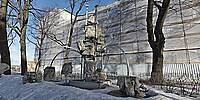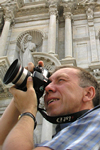
Fountain of Flying up Stones
Millionnaya Street, Saint Petersburg, Russian Federation
February 27, 2022 - 11:00 GMT
© 2022 Andrew Varlamov, All Rights Reserved.
Though composition "Fountain of Flying up Stones" was installed and inaugurated at the turn of 2019 year, it is older than the equestrian statue of emperor Alexander III in the courtyard of Marble Palace in Saint Petersburg. The composition is designed by the Russian sculptor Dmitry Kaminker.
During the Second World War some urban sculptures were removed from their pedestals and buried to protect them from enemy shellings and bombings. The most famous ones are Horse Tamers on the Anichkov bridge, they were buried in the nearby Anichkov Palace garden in 1941.
After the Second World War citizens begun to dig up such sculptures. Occasionally in different parts of the city there were found 16 separate fragments carved out of Pudost stone - piece of drapery, piece of leg, sheep's head with beautiful crumpled horns... Probably these artworks were created in XVIII century to decorate facades of buildings, but some time later due to unknown reasons they were placed in the earth and covered with soil, and became peculiar archaeological objects.
Heavy fragments, the weight of each one reached 1 ton, were subject to disposal. But Tatyana Borisovna Manturova, then a young employee of the State Russian Museum, and later the head of the department of Soviet sculpture, demanded that these fragments be kept in the courtyard of the Benois Wing. For many years, sculptural fragments coexisted with
equestrian monument to Alexander III, who was here in exile. In 1994 the monumental work of Paolo Trubetskoy moved to the courtyard of the Marble Palace, where a branch of the State Russian Museum was opened. What to do with the stones has not been decided. The stones were not registered in the museum, not on regular inventory. Dmitry Kaminker knew about the existence of the fragments, he had the idea to use this “archeology” to decorate the inclined passage of the Admiralteiskaya metro station, as an immersion into urban archeology. But these plans were not destined to come true.
A few years ago, the Academic Council of the State Russian Museum, on the initiative of its employees Alyona Vasilevksaya and Alexander Borovsky decided to give fragments to Kaminker so that he can think of a worthy use for them.
Lat: 59° 56' 43.397" N
Long: 30° 19' 39.7" E
Precision is: Medium. Nearby, but not to the last decimal.
Camera: Pentax K-5 II; Lens: Samyang 8mm f/3.5 UMC Fish-eye CS II; Hot shoe two axis double bubble spirit level: ROWI 197;Cable switch: CS-205; Shooting without tripod manual by Nuno A. Madeira (Portugal); PC Software: PTGui Pro 12.7 by New House Internet Services B.V. (dated by June 22, 2021), Pano2VR 6.1.8 pro 64bit by Garden Gnome Software (dated by May 25, 2020)
The Museum of Architectural Ceramics was opened in the Gosudarev Bastion of the Peter and Paul Fortress on October 5, 2018 This is an exhibition on architectural history that presents examples of architectural ceramics At the moment, the museum presents unique items from more than 12 different public and private collections These are tiled stoves and fireplaces, tiles, fragments of ceramic inner and interior decorations of historical buildings, dating from the 17th–21st centuries
9:37 GMT Yellow room
9:41 Blue room
9:45 Green room
9:47 Green room


 Tap or click the zoom icon in the bottom right corner of the picture to switch between in-page and fullscreen view
Tap or click the zoom icon in the bottom right corner of the picture to switch between in-page and fullscreen view